Greetings, today we’re going to play a little game for guitar. We’re going to construct a metal rhythm by rolling a dice to determine the note values. This can be a fun way to come up with some interesting ideas. It can also help get you out of a rut if you are feeling like your rhythms are starting to all sound alike. Don’t worry, we won’t be removing the creative process and leaving everything to chance! The dice will determine the note values but it will be up to you to select the actual notes and dynamics you play them with. Let’s get started!

Contents for This Lesson:
Roll For Rhythms is a simple game for guitar. In this post we’ll do 3 “Rounds” plus a Bonus section. Use these links to jump to the section of interest or start from the top to cover everything.
04: Round Three →
05: Bonus Round →

Roll for Rhythms: The Rules
Okay so to start off we need to know the rules of our game. Having done a few tests there are several ways you could approach this. In this post we’ll look at one method which I found worked quite well. We’ll also look at a slight variation too. So here are the ‘rules’ of Roll for Rhythms:
Each number on the dice will correspond to a note value or rhythmic idea. These are:
- Quarter Note (1/4)
- Eighth Note (1/8)
- Eighth Note Triplet (1/8t)
- Sixteenth Note (1/16)
- Gallop (Either 1/8 + 1/16 + 1/16 OR 1/16 + 1/16 + 1/8)
- Wild Card – This can either be a Sixteenth Note Triplet, a Half Note or a Chord of any note length.
To avoid things getting too complex we’ll use a group of notes for each roll. For example if I roll a 4 I will write down 4 sixteenth notes, rather than just 1. If I roll a 6 and choose 1/16 triplets then I will write down 6 of these as that is how they would normally be grouped. This will make more sense later. Basically we want each roll to be 1 full beat. We’ll also do a variation where we just select 1 note of whichever value we have rolled to look at how this makes things more complex.
Finally you can add or remove a note if you wish in order to make each bar of music work. So for example in 4/4 time signature and you may end up with too many or too few notes. You are allowed to “tweak” one of your rolls to make the bar the right length.

A Game for Guitar – Round 1:
Okay so here is an example of how the game works. I rolled the dice 8 times. The numbers were:
5 – 6 – 6 – 3 – 2 – 3 – 1 – 5
I wrote out each note value and decided what to do for the “6’s”. So the note lengths are going to be:
A Gallop. Wildcard – I picked 1/16 triplets. Another Wildcard – I picked a chord with the length of a quarter note. An 1/8th note triplet. This made up 1 bar, we’ve used the first 4 rolls (5, 6, 6, 3).
The second bar uses the remaining rolls (2, 3, 1, 5). This gives us 2 1/8th notes. An eighth note triplet, remember I am using 3 notes tied to form the triplet rather than just a single note. A 1/4 note. Finally another Gallop.
For the Gallops I used 1/8 + 1/16 + 1/16 for the first one and the opposite for the second. That would be 1/16 + 1/16 + 1/8.
Side note:
You might be thinking that you could also play a gallop as 1/16 + 1/8 + 1/16. You can do this but it sounds more like a Jazz rhythm than a galloping sound.
Visualising the Rhythm:
It’s much easier to understand what we’re doing here by visualising it in a diagram and hearing an example. Here is my 2 bar rhythm:
I used the open low E string for most of the notes, occasionally adding an F on the first fret. For the second roll of the number 6 (Wildcard) I decided to stick in an Em chord for a 1/4 note length. Here’s how it sounds:
Here is the same rhythm again but this time I changed the notes. This example is played on an 8 string guitar. We’re using the F# and low B strings for most of the notes. The Em chord is still there played across the first five strings as before. Patrons can download Guitar Pro tab for all examples in this lesson.

A Game for Guitar – Round 2
Here is another example of how this game can help you come up with new rhythm sections. Again I rolled 8 times. This time I rolled the numbers 1, 6, 6, 2, 3, 2, 5, 5.
This gives us a 1/4 note followed by two “wildcard” rolls, I decided to do a groups of 1/16 Triplets for the first and a chord lasting a 1/4 note for the second. Next up was two 1/8th notes. This added up to a full bar in 4/4 time signature.
For the second bar the numbers rolled gave me a group of 1/8th note triplets, another group of straight 1/8th notes and then two gallops. For both I used two 1/16ths followed by an 1/8th note.
Below is a more visual example of the timing followed by some audio clips:
For the first example of how you can apply the notes to this I used the key of A minor. For the “wildcard” chord on beat 3 of bar 1 I used Am. The rest of the riff is made up of single notes, some palm muted on the low E string.
For the second example I moved to 7 string. I start on a B power chord, then play the open B string palm muted. This time the “wildcard” chord is a C power chord. This puts us in B phrygian from the key of G Major. All the remaining notes are the open B string again, palm muted. Not much variation of notes but it sounds heavy and effective.

A Game for Guitar – Round 3
This time I rolled the dice 10 times. The results were 4, 4, 6, 4, 2, 5, 3, 4, 4, 6. By now you’re hopefully getting the idea so I won’t list out the note values. You can check the rules section above. However Instead of two bars like before we end up with three. For the third bar I changed the time signature from 4/4 to 3/4. This bar contains a group of 1/16th notes followed by a chord held for a 1/2 note (2 beats).
Here is the first audio example:
This riff would probably be best used as a bridge in to the next part of a song. However for the example I have looped it 4 times like the other examples.
For the second example of this rhythm I used an 8 string. Here we are playing the open F# and the first fret, G with palm mutes for the first two bars. Then we move up to the 13th fret and play a tapped lick on the low E string to finish off. However this time I have used some rests at the start of the 2nd and 3rd bars. Again this rhythm is split in to two bars of 4/4 and one bar of 3/4.

Bonus Round – Variation of the Rules:
So far we have tried to make each roll of the dice last one beat. So rolling a 2 gives us 2 1/8th notes. Rolling a 3 gives us 3 1/8th note triplets and so on. For the wildcard in Round 3 I used a 1/2 note which is 2 beats. This time we will just use 1 of whichever note value we roll. This means rolling a 3 will give us just a single 1/8th note triplet.
Playing the game this way will yeild more unnusual timing. You could consider this “Hard Mode”.
Here is a clip of the rhythm, from Round 1 except this time I have used just 1 of each value. The only exception is when you roll a 5. Since a gallop has to be 3 notes we will still use 1/16 + 1/16 + 1/8 or 1/8 + 1/16 + 1/16 . So we have:
Gallop – 1/16 triplet – 1/16 triplet – 1/8 triplet – 1/8 – 1/8 triplet – 1/4 – Gallop.
In order to loop this I am thinking of it as 1 bar in a 9/8 time signature. Here is an audio clip:
As you can hear this has quite an unnusual flow to it. I’ve kept the note choices pretty simple for now just an open E and Bb a tritone above.
Closing Thoughts:
I hope you’ve enjoyed this lesson/game. The idea is to mix up your practice with something a bit different. Hopefully “Roll for Rhythms” will help you come up with rhythmic structures you might not otherwise have thought of. You could apply this to chord strumming as well as metal rhythms to help get the creative juices flowing. While intended as a game for guitar it is also a useful practice tool.
The idea was originally inspired from watching the Oxventure (An online Dungeons and Dragons campaign by the channel Outside Xbox) on youtube during the covid pandemic. I’ve tried to keep the game fairly simple for now but we have some ideas for possibly expanding on this in future so stay tuned!

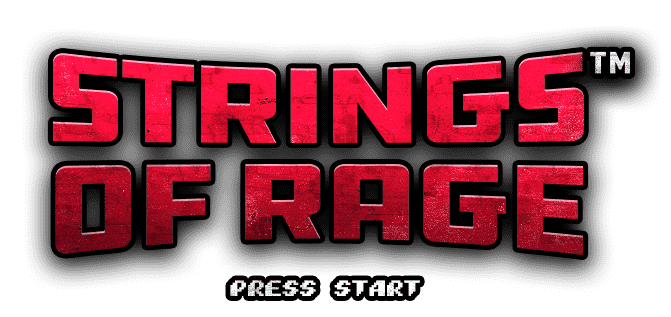
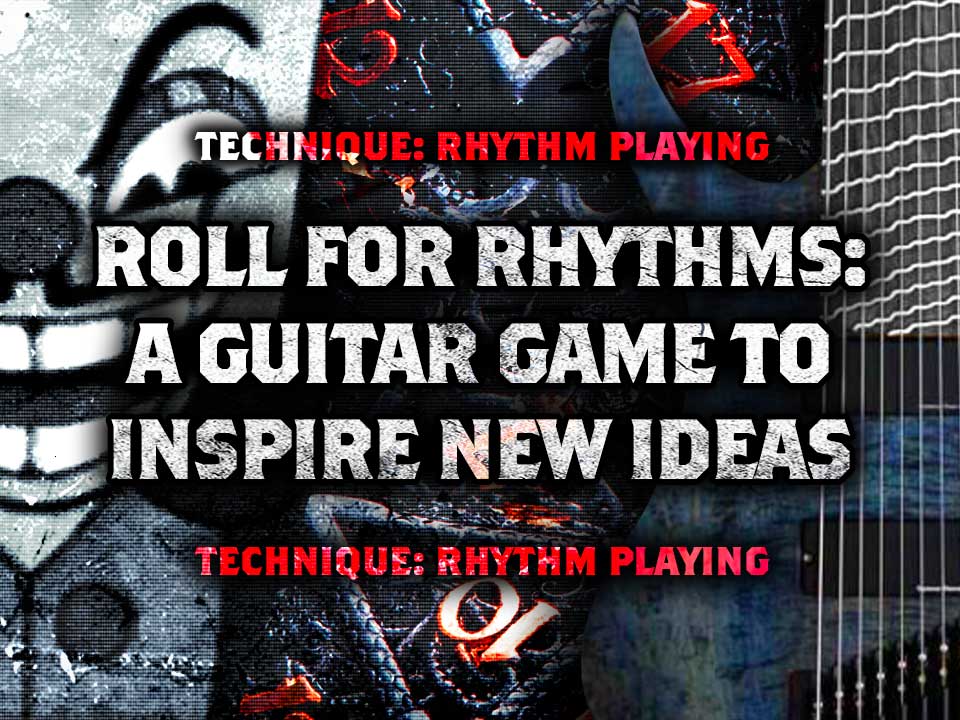
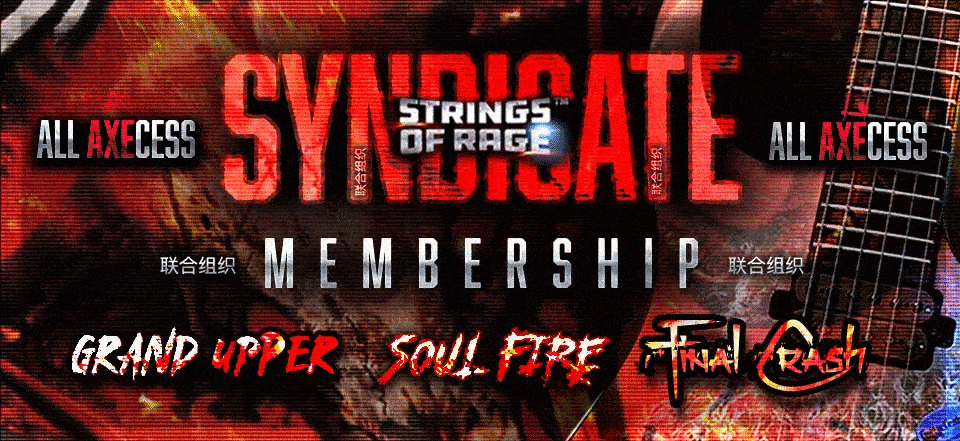
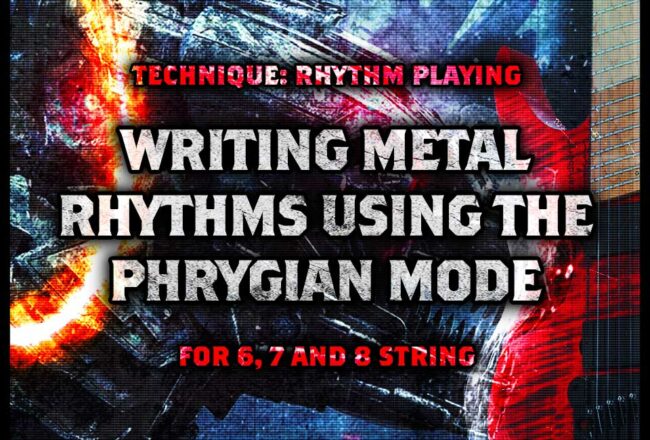

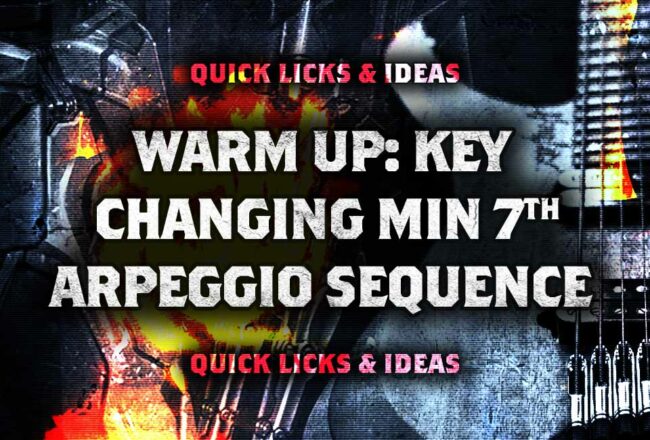



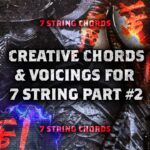


No Comment